
I recently had the pleasure of meeting Alberto Chiarlo, son of Michele who established the family’s eponymous winery in Italy’s renowned Piedmont region in 1956. The Chiarlo wines represent this family’s dedication to the mastery and expression of Piemontese terroir through the use of indigenous grape varieties, innovative viticultural practices and seven generations of winemaking tradition.
We met at Piattini, a new Italian eatery in Boca Raton’s Royal Palm Place, whose deliciously authentic cuisine provided the perfect accompaniment for the featured wines. As we took our seats Chiarlo explained, “We make wine to go with food,” reinforcing one of my favorite things about Italian wine, “and Piemonte is the food capital.” With just shy of 20 Michelin-starred restaurants in the region, he made an excellent point.

We began the tasting with the 2012 Chiarlo Gavi “Le Marne,” a delightful white wine made from 100% Cortese grapes with inviting aromas of white flowers, citrus and minerals. Chiarlo explained, “Our goal is to make wines that are expressive of the soil, [they are] not super modern.” Stefano Chiarlo, Alberto’s brother and Chiarlo winemaker, generally abstains from the use of temperature controlled fermentation and new French oak.” [We are] traditionalists and use the same style now as my grandfather. Our wines are grown in the field…the less touch in winemaking, the better.” This bright white wine had flavors of white peach and lemon accompanied by a crisp acidity which paired deliciously with the freshly grilled octopus.
Of all their wines, Barbera is most definitely at the heart of the Chiarlo ethos. This might sound surprising in the context of this region which deifies the Nebbiolo grape and has historically considered Barbera a simple, one-dimensional offering not suitable for much more than everyday enjoyment. However, Barbera was essentially the first wine the Chiarlo family produced and over the years they’ve done much to elevate its reputation. “Our first goal is to make Barbera,” Chiarlo stated with conviction. In order to produce the finest incarnation of this grape, the winemaking team implements green harvesting, a technique first introduced to the region by Michele Chiarlo in which the fruit of the vigorous Barbera vines is dramatically thinned, resulting in fewer grapes of higher quality with the goal of creating a more complex and potentially age-worthy wine.
Since Barbera plantings must vie for land with Nebbiolo in the town of Alba, another region known for producing much of Piedmont’s Barbera wines, Barbera from Asti is generally considered more structured and complex due to the availability of superior vineyard land. The 2011 Barbera d’Asti Superiore “Le Orme,” is made from fruit sourced in the southern part of Asti from the hills around Nizza Monferrato. The wine is fermented for ten days in stainless steel tanks and then aged for eight months in large French oak casks prior to release. The wine had enticing aromas and flavors of black fruit, cassis and spice as well as a lovely hint of violet. On the palate, the wine had a velvety mouthfeel while the acid and tannin struck a harmonious balance. This wine was perfect for enjoying on its own but also paired extremely well with the flavors of the Prosciutto di Parma and decadent duck pate.

In addition to the “Le Orme,” we also sampled the 2009 Barbera d’Asti Superiore Nizza “La Court,” Chiarlo’s single vineyard Barbera made from fifty year old vines and only in the best vintages. Again, Chiarlo stressed the wine was, “very traditional, [fermented in] open vats with no temperature control. In order to do this we must have perfect grapes.” Fermentation in large oak casks was followed by an additional twelve months of oak aging resulting in a wine with structure and balance as well as heady aromas and flavors of ripe cherry, plum and spice with a tangy acidity and lengthy finish. This wine is delicious now but will continue to benefit from and evolve with additional time in the bottle. The “La Court” synergized deliciously with the Aged Goat Cheese studded with heavenly bits of Black Truffle.

Next were a dynamic duo of Chiarlo Barolos, the 2008 Tortoniano and the 2009 Cerequio. The ’08 Tortoniano Barolo is named for the tortonian-era soils in which the Nebbiolo vines are grown. This wine is more feminine in style than the other Chiarlo Barolos and is considered a great introduction to this wine known for its abundant levels of both acid and tannin. This wine is aged in oak barrels for two years and an additional year in the bottle prior to release resulting in a wine with a vibrant garnet color and fragrant aromatics of red cherry, roses and black truffle. On the palate flavors of pomegranate, ripe cherry, spice and Piemontese earth are accompanied by soft tannins and a lengthy, spice-tinged finish.
The Cerequio vineyard’s soil composition, southern exposure and mild climate make it one of the most prestigious crus of the Langhe. Located at 1,200 feet elevation within the La Morra commune the vineyard’s soils are rich in magnesium which has been found to result in wines of great elegance. Fermentation on the skins is followed by aging for two years in large oak barrels and an additional fifteen months in bottle before release. The resulting ’09 Cerequio Barolo was indeed elegant with complex, layered notes of black currant, cherry, spice and anise. This rich, full-bodied red clearly exhibited the hallmark acid and tannin levels often associated with these renowned wines and will most definitely age gracefully for years to come. Following Chiarlo’s lead, I also ordered the Bucatini Amatriciana, a pasta dish featuring crispy guanciale (cured pork jowl/cheek), flavorful pomodoro sauce and an ample dusting of Pecorino Romano cheese. The housemade bucatini pasta was cooked perfectly “al dente” which brought a smile to Chiarlo’s face as well as all who ordered it. Needless to say it was the perfect accompaniment for both Barolos demonstrating how a robust wine can stand up to a dish with comparable levels of flavor and texture which, in return, will serve to tame the wine’s acid and tannins.

The Michele Chiarlo wines offer a wonderful opportunity to explore Italy’s Piedmont wine region, one of the most renowned wine regions in the world. Whether you’re looking for a crisp, refreshing everyday white wine; an immensely enjoyable selection of red wines or age-worthy additions for your wine cellar there’s definitely a little something for everyone. Also, if you live in the Boca/Delray area (or happen to be visiting) be sure to visit Piattini Ristorante located at 187 SE Mizner Blvd in Boca Raton. For information on purchasing any of the Michele Chiarlo wines, please click here to visit The Wine Atelier.
Cheers,
![]()

With your New Year’s Eve hangover in the rear view mirror and the long, winding road of 2014 laid out before you, here are 5 wine-related resolutions to help you embrace and explore the world of wine in the New Year.
1.) Mix It Up: Because the world of wine is so vast and often confusing it’s easy to just stick with the same wine, day in and day out. To break out of your wine rut, why not vow to sample a different wine every week or learn more about a specific wine making region? Find a reputable retailer who can guide you towards selections you might like or subscribe to a publication and/or website where you can learn more about a variety of wine regions around the world. Here on the blog we plan on offering an array of wine coverage in the New Year and our Explorateur Wine Club is a wonderful way to explore a different wine region every month!
2.) Start a Wine Collection: If you’ve been drinking wine long enough to have a favorite wine region and/or producer it’s probably a good time to start collecting. Collecting wine does not mean you have to commission a custom built 15,000 bottle capacity cellar – far from it! All it takes to start a collection is a small wine fridge and a few age-worthy bottles to put in it (for some age-worthy wine recs, please click here). The wine fridge is an important piece of equipment for the beginning collector. Please don’t forgo this purchase and make the mistake of storing your wines in a spare closet or on the kitchen counter. The varying temperatures and humidity levels in any home (kitchens are the worst!) are the arch-enemies of wine so be sure to protect your investment with this useful piece of equipment. Also, wine lovers invariably have a way of outgrowing wine storage units so, if your budget allows, purchase a fridge with a little room to grow.
3.) Drink more white wines that are NOT Pinot Grigio: Much like Rodney Dangerfield, white wine often “gets no respect”. I conduct many tastings where people want to skip right over the white wine and go straight to the red. Sometimes it’s personal preference but, more often than not, I think people are under the impression that red wines are somehow superior to whites, which couldn’t be farther from the truth! People are also under the mistaken impression that all white wine tastes like the bland, mass-produced Pinot Grigios we often encounter which doesn’t help white wine’s reputation. It’s rewarding to see someone’s face light up after taking a sip of White Burgundy or Alsatian Gewürztraminer and marvel at their flavor and complexity. So whether it’s Gewürztraminer, Viognier, Arneis or Chenin Blanc embrace the world of white wine but, whatever you do, stay away from the Pinot Grigio! For a selection of delicious whites from The Wine Atelier, please click here.
4.) Drink more sparkling wines: Unfortunately sparkling wines are most often associated with special occasions and New Year’s Eve celebrations, leaving the majority of the year unbearably bubbly-free. While Champagne’s price may limit it to more of a special occasion selection, there are many sparkling wines from around the globe whose price point makes them a perfect candidate for an everyday wine. Wines like Prosecco, Cava and Crémant retail for under $20 (for some examples, please click here) making them perfect for enjoying on a Tuesday night after work or when a friend stops by to visit. As an added bonus, sparkling wines have less calories and alcohol than a glass of Chardonnay or Pinot Noir. Affordable, delicious and figure-friendly – what’s not to love about that?
5.) Wine-related Travel: Next time you’re booking a Spring or Summer getaway why not head to your favorite wine region? Nothing will give you an appreciation for what’s in your glass more than standing in the vineyard where the grapes are grown and talking to the people who make the wine. Whether you’ve collected for some time or are new to enjoying wine, traveling to different regions can be a lot of fun and facilitate your passion for the subject. Start with a region you’re interested in and plan from there. Don’t be afraid to reach out to the wineries directly, they’re usually very happy to hear from you. Of course here at The Glamorous Gourmet we’re always happy to assist you with wine and food related travel so please don’t hesitate to reach out. Here’s a link to some of our travel-related articles.
I hope these suggestions help you make it through 2014 with a renewed passion for all things vinous! If you have any other wine-related resolutions we’d love to hear about them, please tell us in the comment section below.
Cheers,
![]()
If you are a fan of food and wine and plan most of your travel around taking in the culinary and vinous sights you won't want to miss this very special Day Trip to Burgundy with The Cook's Atelier. Beaune is a mere 2 hour train ride from Paris on the TGV high speed train and a visit to this incredibly charming town is so worth it.We had the pleasure of spending a truly delightful day in Beaune, the wine capital of Burgundy, with Marjorie Taylor and her daughter Kendall Smith Franchini, Founders of The Cook's Atelier. Originally from the US, Marjorie and Kendall followed their bliss to France and started their new venture five years ago. Kendall had been living in France for ten years, going to school and then working for Christie's Auction House and wine importer Kermit Lynch. Marjorie was co-chef proprietor of the award-winning restaurant and cooking school, Ruby Beet Gourmet, in Phoenix, Arizona prior to making the move overseas. She had also studied at La Varenne cooking school under noted teacher and cookbook author, Anne Willan. Together, this mother daughter team decided they wanted to be on the same side of the pond and now offer market tours and hands-on cooking classes to students lucky enough to score a spot in one of their highly coveted classes. And for good reason, the "Market Tour & Lunch" class we experienced was hands down one of the highlights of our trip and the perfect option for a Day Trip to Burgundy.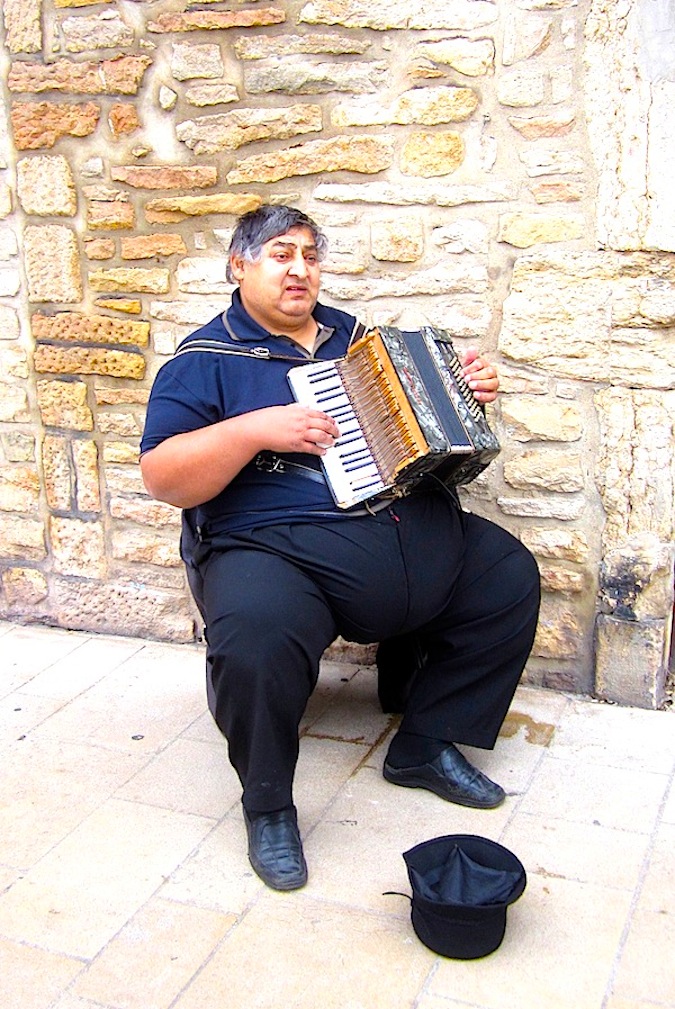
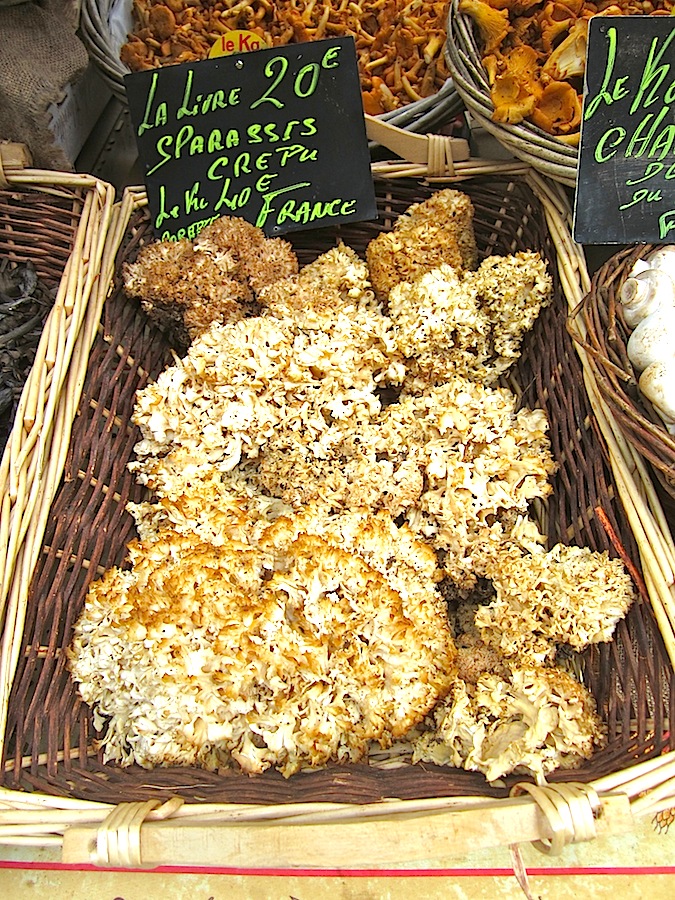
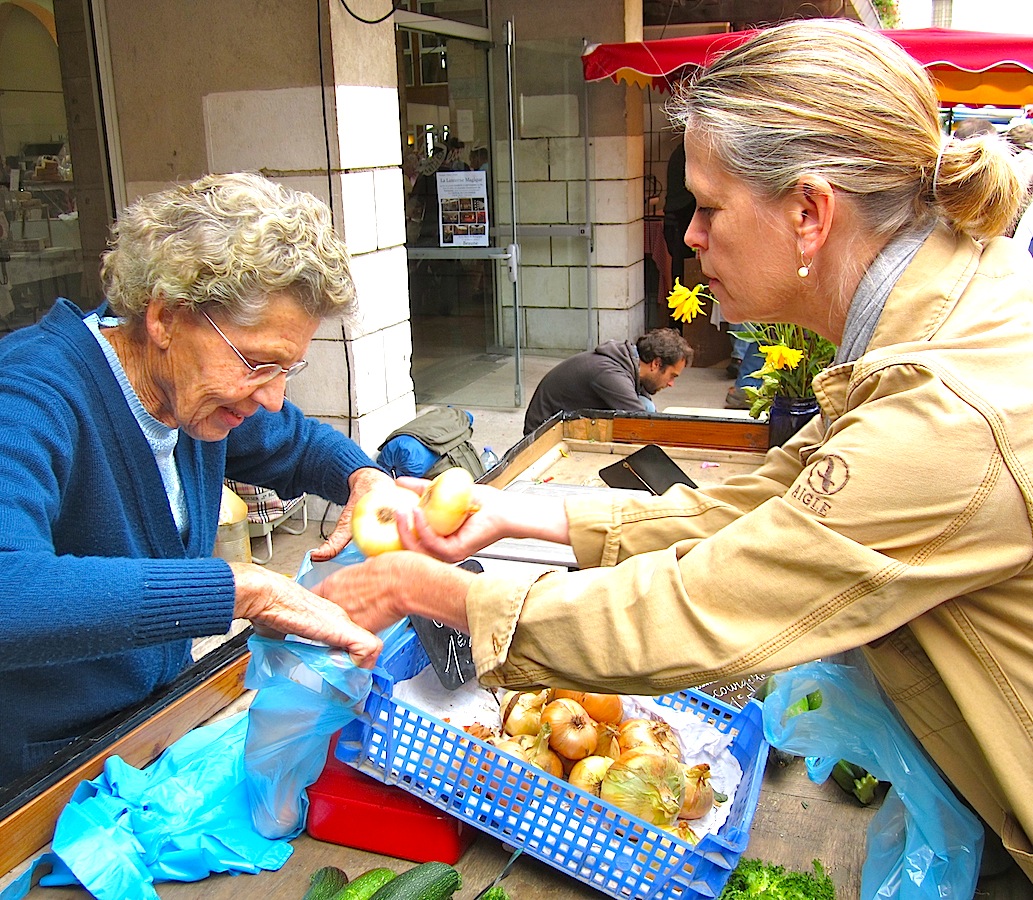
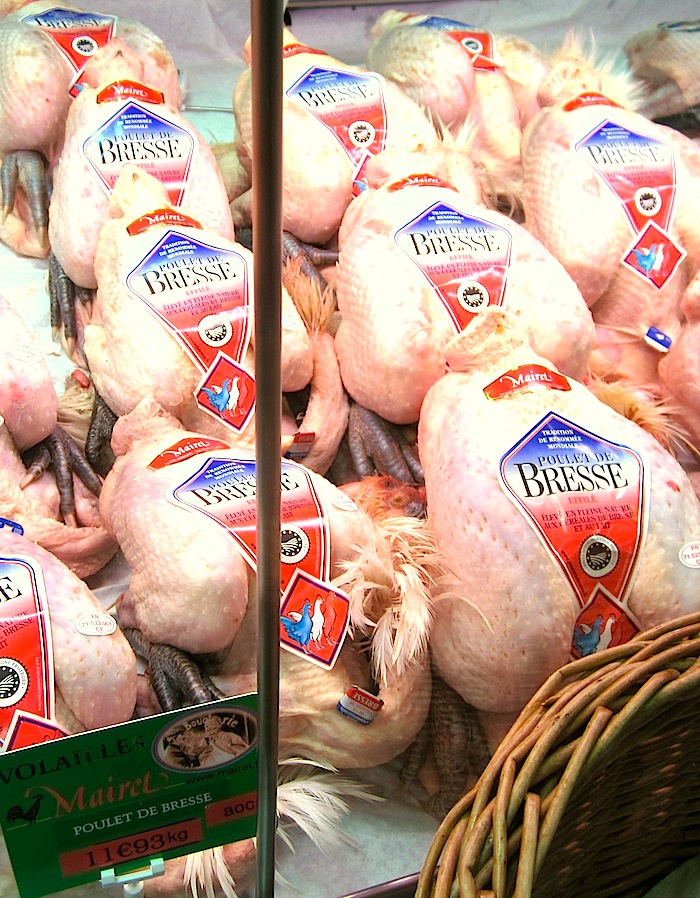 Many people had recommended we see the Beaune market during our visit and we considered ourselves very fortunate to have Marjorie as our guide - there was so much to see! As we made our way through the vast marketplace, Marjorie introduced us to her favorite purveyors of produce, meats and cheeses. Everything from Bresse chickens to Truffe de Bourgogne beckoned - it was truly a feast for the senses. After we had procured the ingredients for our lunch, we took the short walk through the charming town of Beaune to the "atelier" (French for studio or workshop), a small but very elegant and inviting space. A beautiful zinc-topped farm table was the room's focal point as well as a large chalkboard featuring the day's menu. Two generously sized windows allowed sunlight to stream in, giving the space an ethereal feel and making for ideal food photography (coincidence?). To the right was the kitchen, already appointed with work stations where we would all help prepare the day's meal. Everyone got to participate and Marjorie was a very relaxed and patient instructor not to mention the lady can cook!
Many people had recommended we see the Beaune market during our visit and we considered ourselves very fortunate to have Marjorie as our guide - there was so much to see! As we made our way through the vast marketplace, Marjorie introduced us to her favorite purveyors of produce, meats and cheeses. Everything from Bresse chickens to Truffe de Bourgogne beckoned - it was truly a feast for the senses. After we had procured the ingredients for our lunch, we took the short walk through the charming town of Beaune to the "atelier" (French for studio or workshop), a small but very elegant and inviting space. A beautiful zinc-topped farm table was the room's focal point as well as a large chalkboard featuring the day's menu. Two generously sized windows allowed sunlight to stream in, giving the space an ethereal feel and making for ideal food photography (coincidence?). To the right was the kitchen, already appointed with work stations where we would all help prepare the day's meal. Everyone got to participate and Marjorie was a very relaxed and patient instructor not to mention the lady can cook!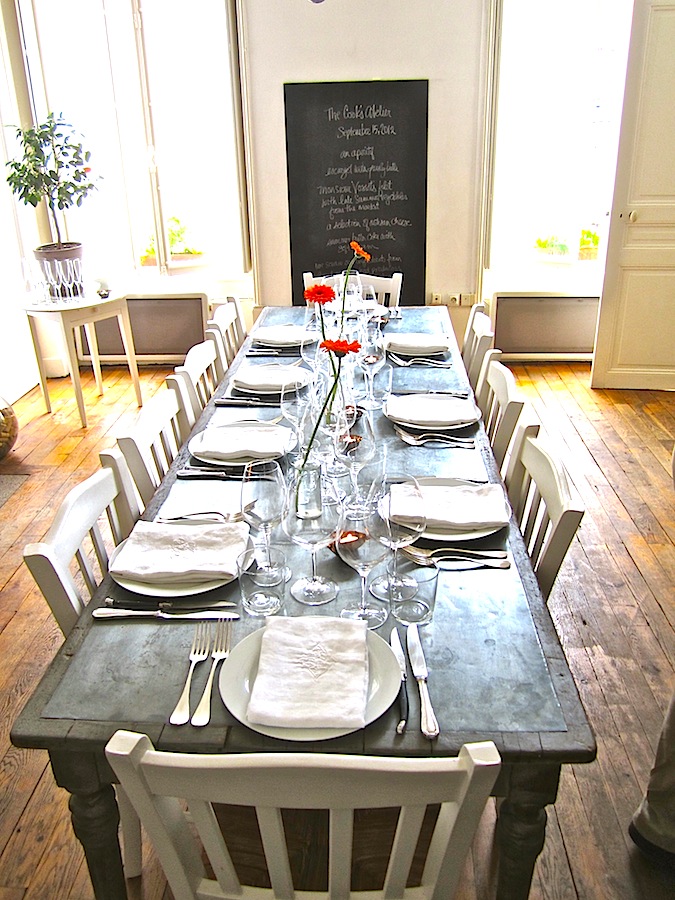
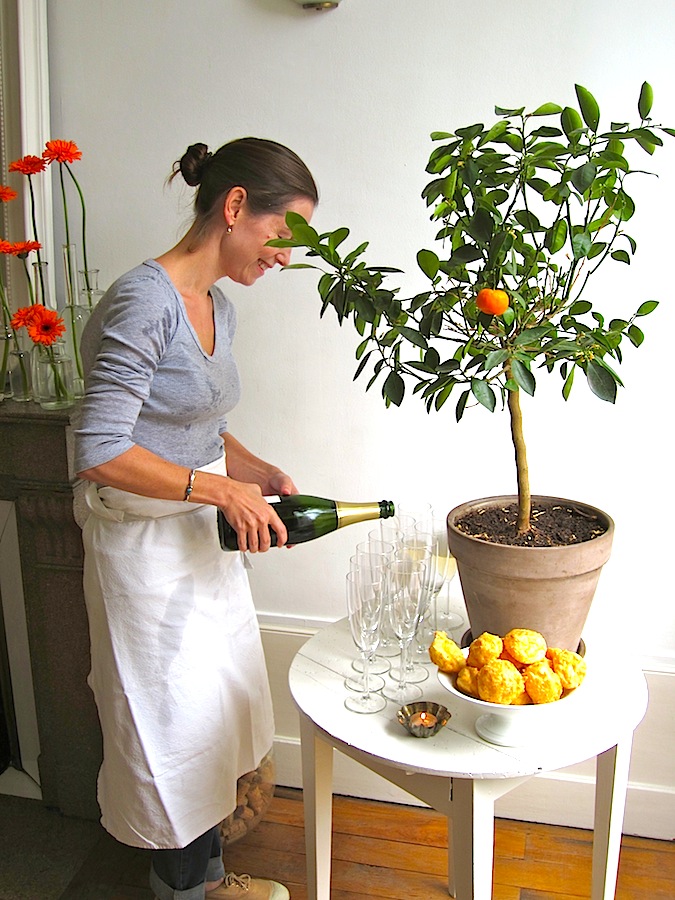
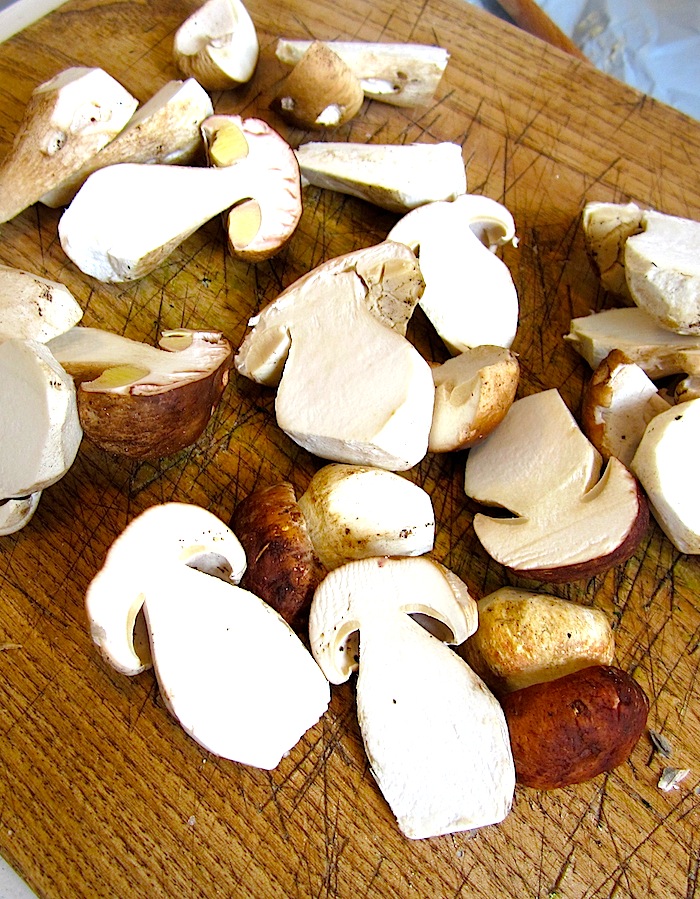
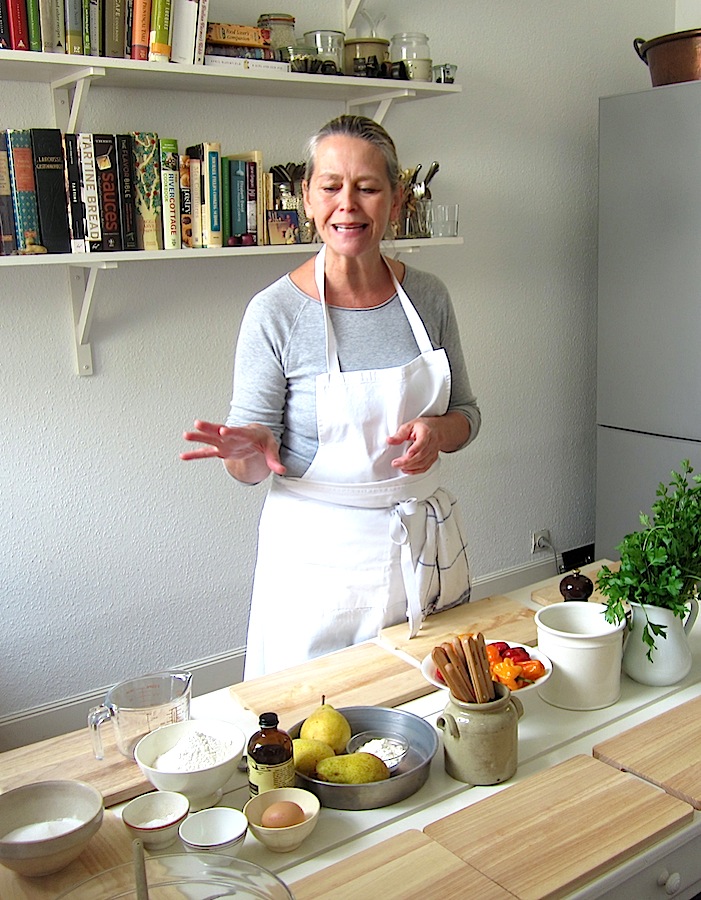
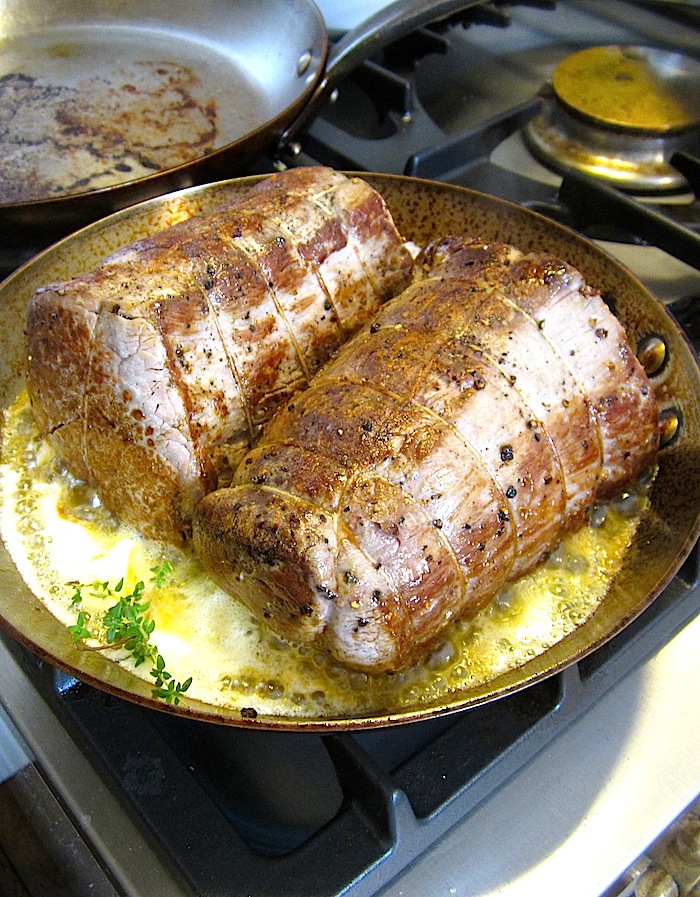 Once finished, we were treated to chilled flutes of Crémant de Bourgogne, Burgundy's sparkling wine, paired with Marjorie's delicious Gougeres which, up until that day, had always seemed too daunting to make. They were warm and divine right out of the oven and took the edge off of our hunger which we were just starting to notice. Soon after we sat down to a beautiful meal of Escargot with Parsley Butter followed by Monsieur Vossot's Filet of Beef with Late Summer Vegetables and Roasted Potatoes with Thyme. By the time our dessert of Summer Butter Cake with Soft Cream arrived at the table we had become fast friends with our fellow students, also visitors from other countries around the world.
Once finished, we were treated to chilled flutes of Crémant de Bourgogne, Burgundy's sparkling wine, paired with Marjorie's delicious Gougeres which, up until that day, had always seemed too daunting to make. They were warm and divine right out of the oven and took the edge off of our hunger which we were just starting to notice. Soon after we sat down to a beautiful meal of Escargot with Parsley Butter followed by Monsieur Vossot's Filet of Beef with Late Summer Vegetables and Roasted Potatoes with Thyme. By the time our dessert of Summer Butter Cake with Soft Cream arrived at the table we had become fast friends with our fellow students, also visitors from other countries around the world.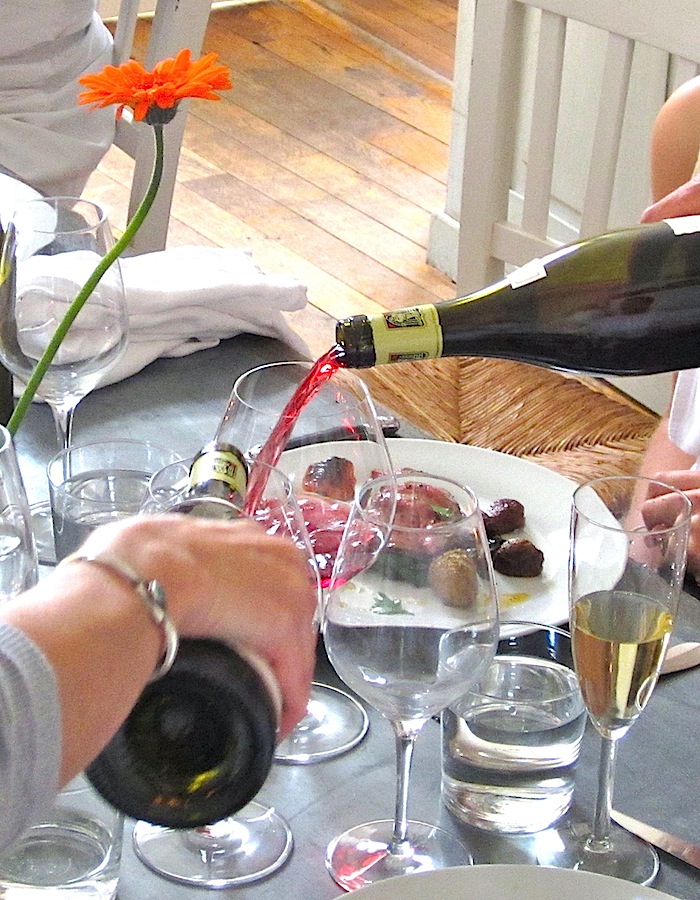
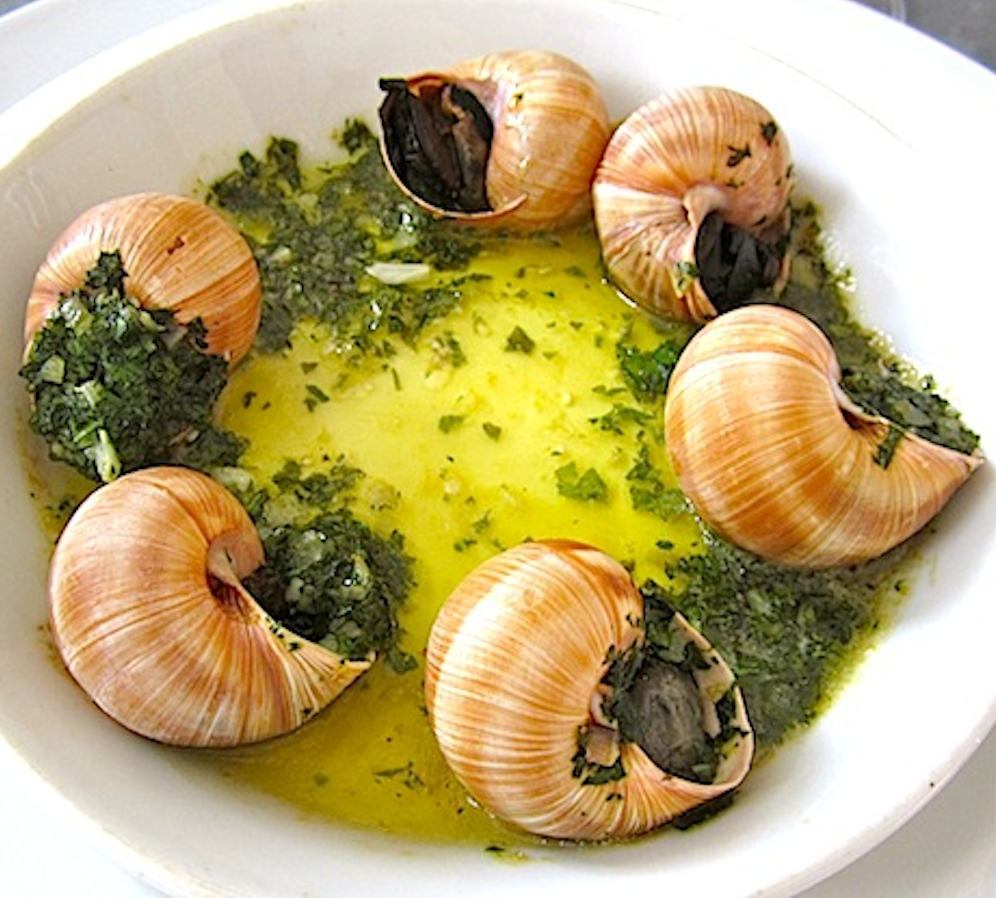
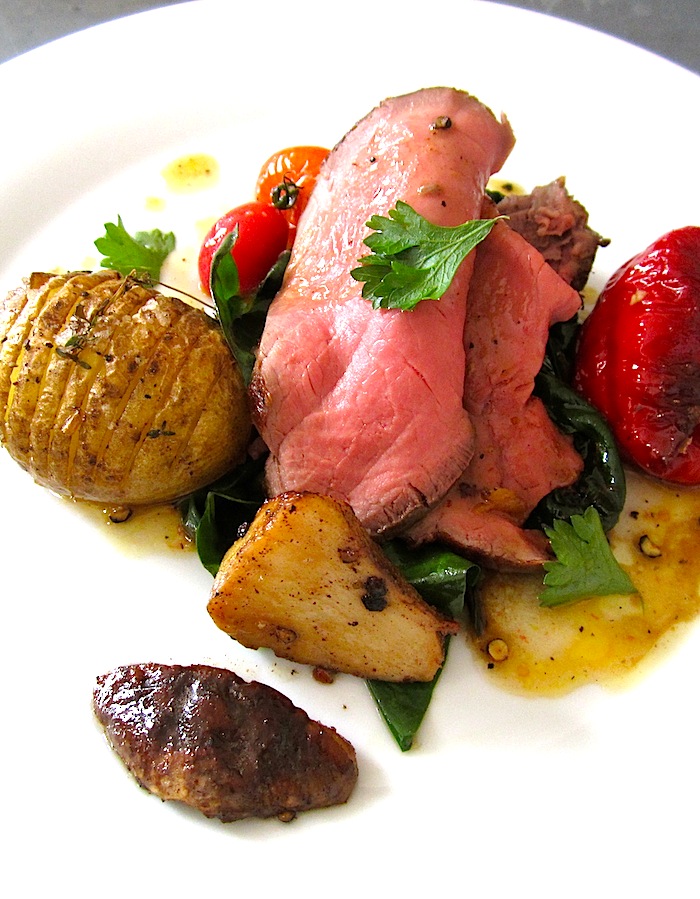
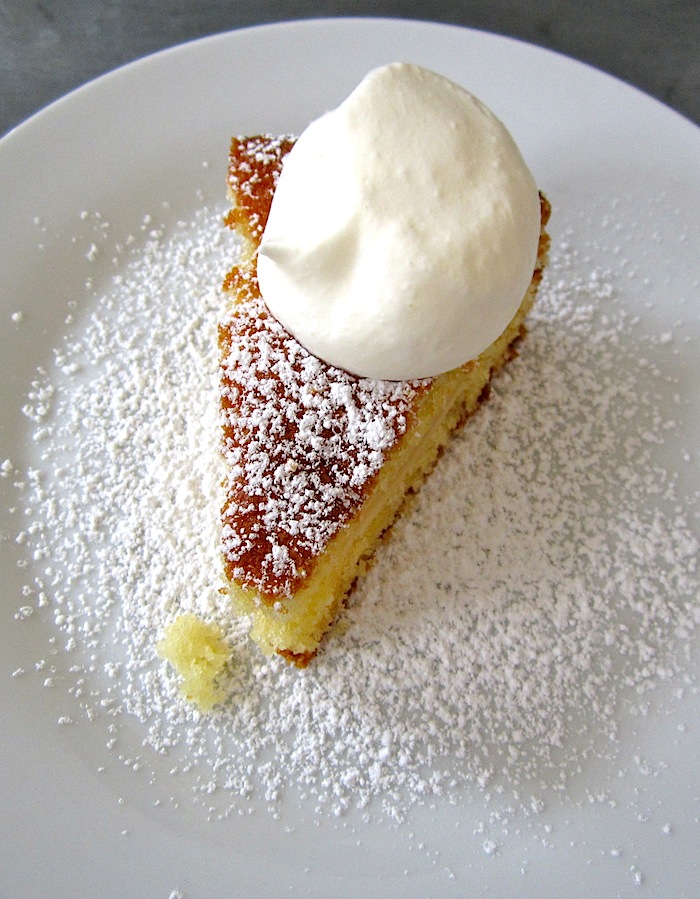 With our meal we enjoyed local wines made from Chardonnay and Pinot Noir (Burgundy's specialty!) and since we also visited Maison Louis Jadot and Maison Joseph Drouhin during our trip I'd like to suggest a few of their wines to pair with this delicious meal. Burgundy is generally a pricy proposition, however, if you're looking for two great values, try the 2011 Drouhin Vaudon Chablis ($25) a citrusy, flinty Chardonnay with a racy acidity which will pair nicely with the rich escargot. For a red, try the 2010 Louis Jadot Chateau de Jacques Morgon ($32) with notes of black cherry and currant with a lovely minerality and supple tannins. If you're looking to kick it up a notch for New Year's Eve, try the 2010 Louis Jadot Meursault ($54), a rich, mineral-tinged white made from 100% Chardonnay, which would make a lovely pairing for the escargot. The 2009 Joseph Drouhin Clos de Mouches ($95), a delicious, cherry and spice-laced red with silky tannins made from 100% Pinot Noir, would complement the filet of beef beautifully. By the time we had finished our "lunch" it was around 5pm, and we were in no rush to leave the "atelier" with its deliciously inviting atmosphere. Reluctantly, we eventually said our goodbyes and made our way back to our hotel. All in all it was a fabulous and memorable day!To access any of the above recipes, just click the recipe names which will take you directly to The Cook's Atelier website. If your travels bring you to France, hopefully you'll be able to enjoy a Day Trip to Burgundy with Marjorie and Kendall to enjoy some of the special culinary delights this very special city has to offer.Bon appétit,
With our meal we enjoyed local wines made from Chardonnay and Pinot Noir (Burgundy's specialty!) and since we also visited Maison Louis Jadot and Maison Joseph Drouhin during our trip I'd like to suggest a few of their wines to pair with this delicious meal. Burgundy is generally a pricy proposition, however, if you're looking for two great values, try the 2011 Drouhin Vaudon Chablis ($25) a citrusy, flinty Chardonnay with a racy acidity which will pair nicely with the rich escargot. For a red, try the 2010 Louis Jadot Chateau de Jacques Morgon ($32) with notes of black cherry and currant with a lovely minerality and supple tannins. If you're looking to kick it up a notch for New Year's Eve, try the 2010 Louis Jadot Meursault ($54), a rich, mineral-tinged white made from 100% Chardonnay, which would make a lovely pairing for the escargot. The 2009 Joseph Drouhin Clos de Mouches ($95), a delicious, cherry and spice-laced red with silky tannins made from 100% Pinot Noir, would complement the filet of beef beautifully. By the time we had finished our "lunch" it was around 5pm, and we were in no rush to leave the "atelier" with its deliciously inviting atmosphere. Reluctantly, we eventually said our goodbyes and made our way back to our hotel. All in all it was a fabulous and memorable day!To access any of the above recipes, just click the recipe names which will take you directly to The Cook's Atelier website. If your travels bring you to France, hopefully you'll be able to enjoy a Day Trip to Burgundy with Marjorie and Kendall to enjoy some of the special culinary delights this very special city has to offer.Bon appétit,

Lately, folks have been asking me what I’ll be making for dinner this New Year’s Eve, and what could be better than a meal inspired by a recent trip to France’s Burgundy wine region?
Last September we had the pleasure of spending a truly delightful day in Beaune, the wine capital of Burgundy, with Marjorie Taylor and her daughter Kendall Smith Franchini, Founders of The Cook’s Atelier. Originally from the US, Marjorie and Kendall followed their bliss to France and started their new venture five years ago. Kendall had been living in France for ten years, going to school and then working for Christie’s Auction House and wine importer Kermit Lynch. Marjorie was co-chef proprietor of the award-winning restaurant and cooking school, Ruby Beet Gourmet, in Phoenix, Arizona prior to making the move overseas. She had also studied at La Varenne cooking school under noted teacher and cookbook author, Anne Willan. Together, this mother daughter team decided they wanted to be on the same side of the pond and now offer market tours and hands-on cooking classes to students lucky enough to score a spot in one of their highly coveted classes. And for good reason, the “Market Tour & Lunch” class we experienced was hands down one of the highlights of our entire trip.

Many people had recommended we see the Beaune market during our visit and we considered ourselves very fortunate to have Marjorie as our guide – there was so much to see! As we made our way through the vast marketplace, Marjorie introduced us to her favorite purveyors of produce, meats and cheeses. Everything from Bresse chickens to Truffe de Bourgogne beckoned – it was truly a feast for the senses. After we had procured the ingredients for our lunch, we took the short walk through the charming town of Beaune to the “atelier” (French for studio or workshop), a small but very elegant and inviting space. A beautiful zinc-topped farm table was the room’s focal point as well as a large chalkboard featuring the day’s menu. Two generously sized windows allowed sunlight to stream in, giving the space an ethereal feel and making for ideal food photography (coincidence?). To the right was the kitchen, already appointed with work stations where we would all help prepare the day’s meal. Everyone got to participate and Marjorie was a very relaxed and patient instructor not to mention the lady can cook!

Once finished, we were treated to chilled flutes of Crémant de Bourgogne, Burgundy’s sparkling wine, paired with Marjorie’s delicious Gougeres which, up until that day, had always seemed too daunting to make. They were warm and divine right out of the oven and took the edge off of our hunger which we were just starting to notice. Soon after we sat down to a beautiful meal of Escargot with Parsley Butter followed by Monsieur Vossot’s Filet of Beef with Late Summer Vegetables and Roasted Potatoes with Thyme. By the time our dessert of Summer Butter Cake with Soft Cream arrived at the table we had become fast friends with our fellow students, also visitors from other countries around the world.

With our meal we enjoyed local wines made from Chardonnay and Pinot Noir (Burgundy’s specialty!) and since we also visited Maison Louis Jadot and Maison Joseph Drouhin during our trip I’d like to suggest a few of their wines to pair with this delicious meal. Burgundy is generally a pricy proposition, however, if you’re looking for two great values, try the 2011 Drouhin Vaudon Chablis ($25) a citrusy, flinty Chardonnay with a racy acidity which will pair nicely with the rich escargot. For a red, try the 2010 Louis Jadot Chateau de Jacques Morgon ($32) with notes of black cherry and currant with a lovely minerality and supple tannins. If you’re looking to kick it up a notch for New Year’s Eve, try the 2010 Louis Jadot Meursault ($54), a rich, mineral-tinged white made from 100% Chardonnay, which would make a lovely pairing for the escargot. The 2009 Joseph Drouhin Clos de Mouches ($95), a delicious, cherry and spice-laced red with silky tannins made from 100% Pinot Noir, would complement the filet of beef beautifully. By the time we had finished our “lunch” it was around 5pm, and we were in no rush to leave the “atelier” with its deliciously inviting atmosphere. Reluctantly, we eventually said our goodbyes and made our way back to our hotel. All in all it was a pretty fabulous and memorable day!
I really look forward to recreating this meal for New Year’s Eve and I hope you enjoy it as well. All of the wine recommendations are available through The Wine Atelier and to access the recipes, just click the recipe names in the above paragraphs which will take you directly to The Cook’s Atelier website. If you plan on traveling to France in 2014, I highly recommend a visit to The Cook’s Atelier. If you’re a foodie I think you would thoroughly enjoy it. Wishing you a very Healthy and Happy New Year!
Cheers,
![]()
Following a fabulous evening at the Camp Schramsberg Library Wine Dinner at Meadowood (read more about that by clicking here), it was nice to get a slightly later start the following morning. After breakfast we hopped back on the buses and headed towards the winery in Calistoga.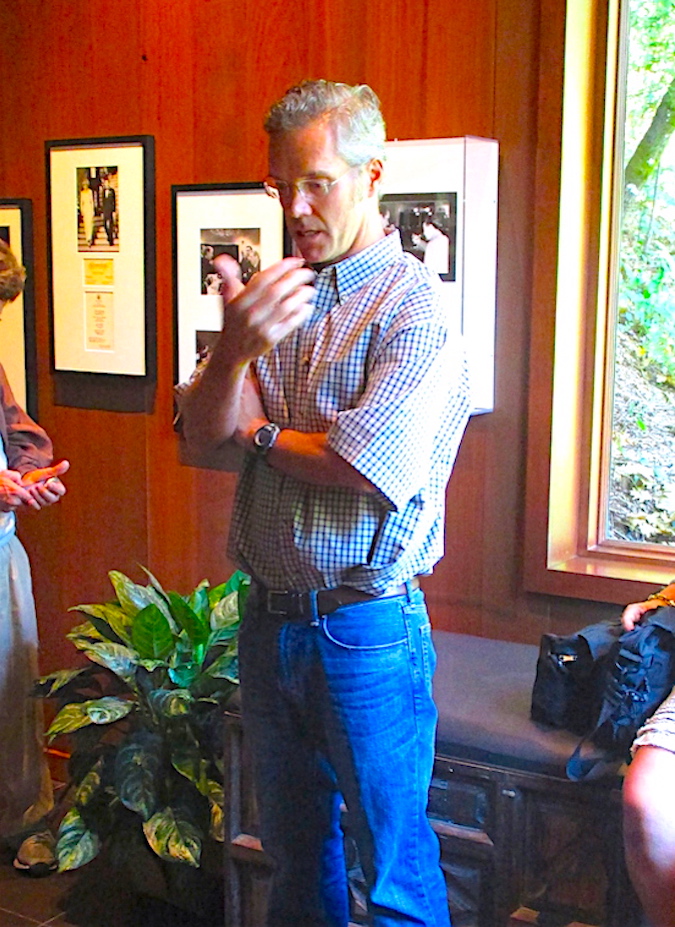
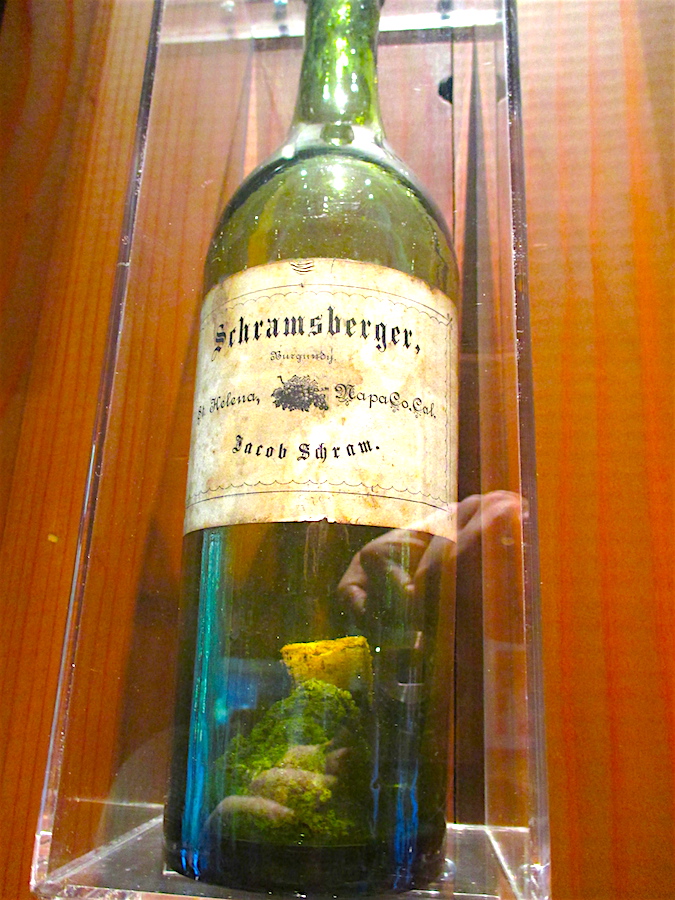
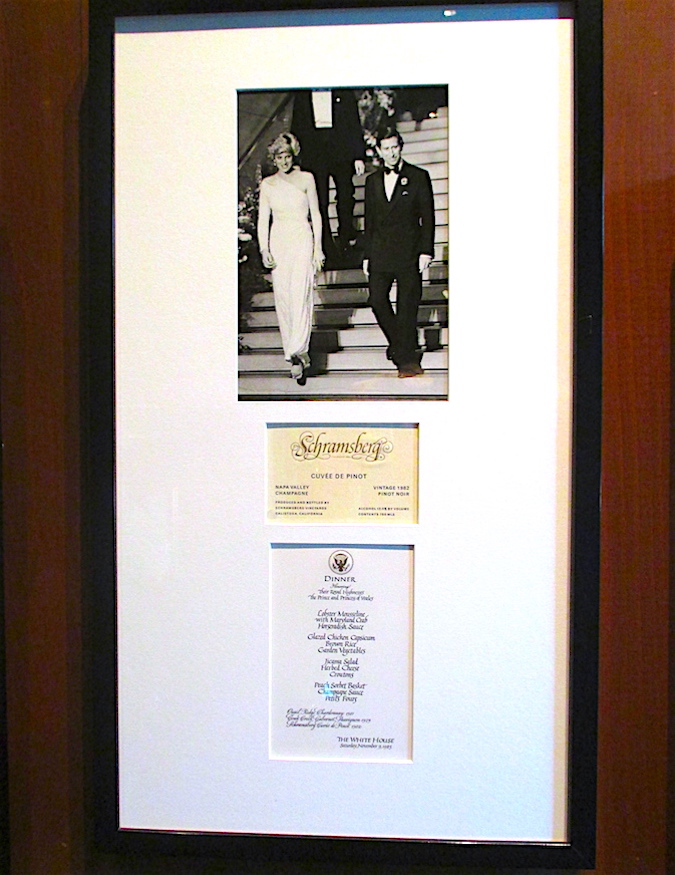 Day two of Camp Schramsberg began with a tour of the winery and its caves given by Hugh Davies. He explained how the estate, a registered historic landmark, has been painstakingly restored by his family when they purchased it in 1965. The Victorian house, the lower winery, the barn and the caves remain largely unchanged since Jacob Schram’s days. He also informed us of the use of Schramsberg's sparkling wines at significant historic Presidential functions. President Nixon's "Toast to Peace" in 1972 with China’s Premier Zhou Enlai in Beijing China featured the Schramsberg Blanc de Blancs. Their sparkling wines have also been served by every U.S. Presidential administration since. As we entered the caves at the winery, Davies explained they were dug primarily with pick axes and shovels in the 1960's. He also shared the details of a harrowing incident immediately prior to the release of the Schramsberg Blanc de Noirs. The press broke and his parents Jack and Jamie Davies had to stomp the grapes with their feet in order to keep production underway to meet their deadline!
Day two of Camp Schramsberg began with a tour of the winery and its caves given by Hugh Davies. He explained how the estate, a registered historic landmark, has been painstakingly restored by his family when they purchased it in 1965. The Victorian house, the lower winery, the barn and the caves remain largely unchanged since Jacob Schram’s days. He also informed us of the use of Schramsberg's sparkling wines at significant historic Presidential functions. President Nixon's "Toast to Peace" in 1972 with China’s Premier Zhou Enlai in Beijing China featured the Schramsberg Blanc de Blancs. Their sparkling wines have also been served by every U.S. Presidential administration since. As we entered the caves at the winery, Davies explained they were dug primarily with pick axes and shovels in the 1960's. He also shared the details of a harrowing incident immediately prior to the release of the Schramsberg Blanc de Noirs. The press broke and his parents Jack and Jamie Davies had to stomp the grapes with their feet in order to keep production underway to meet their deadline!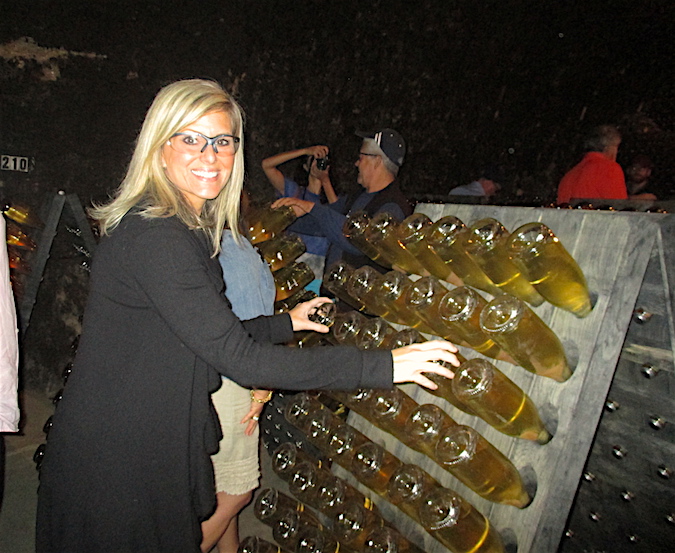
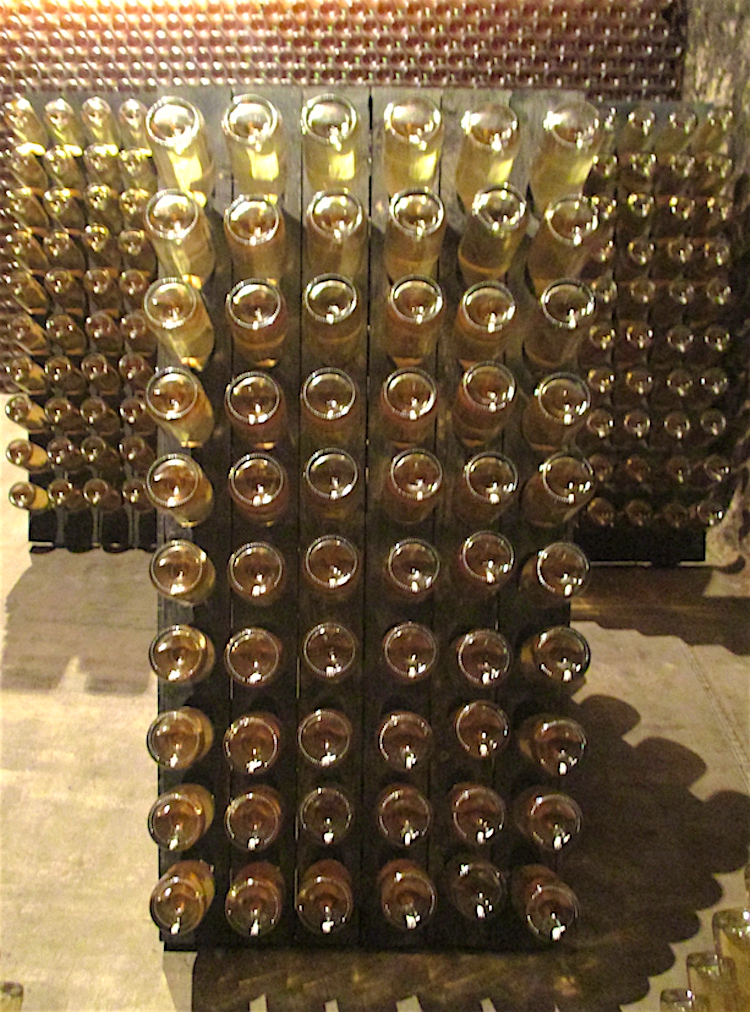 As we made our way deeper into the caves, we reached an opening with multiple rows of riddling racks full of sparkling wine bottles. Here, Davies introduced us to Jesus who'd recently taken over as Chief Riddler for Ramon who'd worked at Schramsberg since the 1970's. Of Schramsberg's total production of sparkling wines, 80% is riddled mechanically using a gyropalette. The remaining 20%, consisting of their more expensive cuvées, is done by hand. Riddling is a very labor and time intensive process which is very important in the production of sparkling wine. By gradually displacing and inverting the bottle, the dead yeast cells generated by the wine's secondary fermentation move towards the neck of the bottle. It is later removed via a process called disgorgement (see video below). Jesus was kind (and patient!) enough to give us all a lesson on how it's done. Upon trying it myself, I quickly realized it took years of practice to master.
As we made our way deeper into the caves, we reached an opening with multiple rows of riddling racks full of sparkling wine bottles. Here, Davies introduced us to Jesus who'd recently taken over as Chief Riddler for Ramon who'd worked at Schramsberg since the 1970's. Of Schramsberg's total production of sparkling wines, 80% is riddled mechanically using a gyropalette. The remaining 20%, consisting of their more expensive cuvées, is done by hand. Riddling is a very labor and time intensive process which is very important in the production of sparkling wine. By gradually displacing and inverting the bottle, the dead yeast cells generated by the wine's secondary fermentation move towards the neck of the bottle. It is later removed via a process called disgorgement (see video below). Jesus was kind (and patient!) enough to give us all a lesson on how it's done. Upon trying it myself, I quickly realized it took years of practice to master.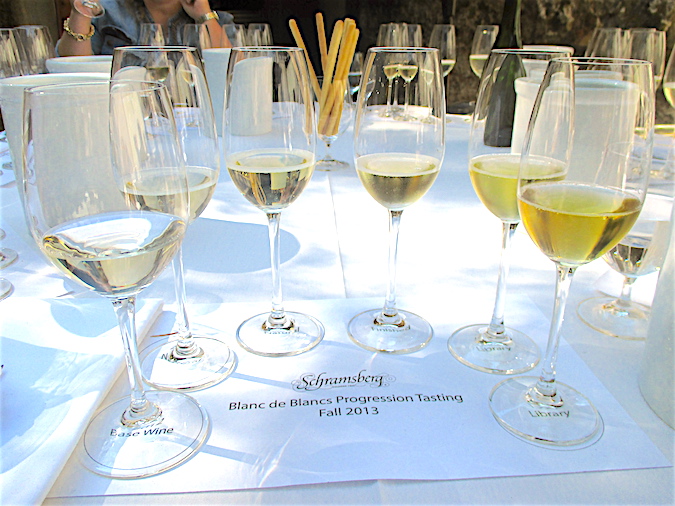 After Riddling 101 we sat down to a Blanc de Blancs Progression Tasting. Guiding the tasting were Schramsberg winemakers Keith Hock, who specializes in sparkling wine, and Sean Thompson, who makes Schramsberg's still wines. During the tasting we were able to sample wines in various states of evolution ranging from a 2012 Base Wine to a 1990 Library Wine. The exercise was very enlightening and beautifully demonstrated how these wines evolve and develop over time. At one end of the spectrum, the 2012 Base Wine exhibited aromas and flavors of tart green apple and citrus while the 1990 Library Wine was at the complete opposite end featuring notes of hazelnut, pastry dough and honey. It was a valuable lesson in the effects of time on sparkling wines and the complexity that can be achieved through proper aging.This exercise led up to perhaps the most exciting, hands on exercise of the trip: we got to make our own unique bottle of Schramsberg sparkling wine to take home with us! We were able to disgorge a bottle of Blanc de Blancs and select the dosage level, which determines the wine's final level of sweetness, to suit our own personal taste. We donned our protective goggles for the disgorgement process but, thankfully, we had winemaker Keith Hock supervising us so nothing went horribly wrong. My disgorgement attempt went very smoothly and when it came time to select the dosage level I decided to approximate Schramsberg's custom cuvee they produce for the The French Laundry. This low dosage sparkler is intended to pair perfectly with oysters and shellfish. After adding the dosage to the wine, I got to cork and label my very own bottle: I'm really looking forward to enjoying the one and only bottle of Cuvée Miskew!
After Riddling 101 we sat down to a Blanc de Blancs Progression Tasting. Guiding the tasting were Schramsberg winemakers Keith Hock, who specializes in sparkling wine, and Sean Thompson, who makes Schramsberg's still wines. During the tasting we were able to sample wines in various states of evolution ranging from a 2012 Base Wine to a 1990 Library Wine. The exercise was very enlightening and beautifully demonstrated how these wines evolve and develop over time. At one end of the spectrum, the 2012 Base Wine exhibited aromas and flavors of tart green apple and citrus while the 1990 Library Wine was at the complete opposite end featuring notes of hazelnut, pastry dough and honey. It was a valuable lesson in the effects of time on sparkling wines and the complexity that can be achieved through proper aging.This exercise led up to perhaps the most exciting, hands on exercise of the trip: we got to make our own unique bottle of Schramsberg sparkling wine to take home with us! We were able to disgorge a bottle of Blanc de Blancs and select the dosage level, which determines the wine's final level of sweetness, to suit our own personal taste. We donned our protective goggles for the disgorgement process but, thankfully, we had winemaker Keith Hock supervising us so nothing went horribly wrong. My disgorgement attempt went very smoothly and when it came time to select the dosage level I decided to approximate Schramsberg's custom cuvee they produce for the The French Laundry. This low dosage sparkler is intended to pair perfectly with oysters and shellfish. After adding the dosage to the wine, I got to cork and label my very own bottle: I'm really looking forward to enjoying the one and only bottle of Cuvée Miskew!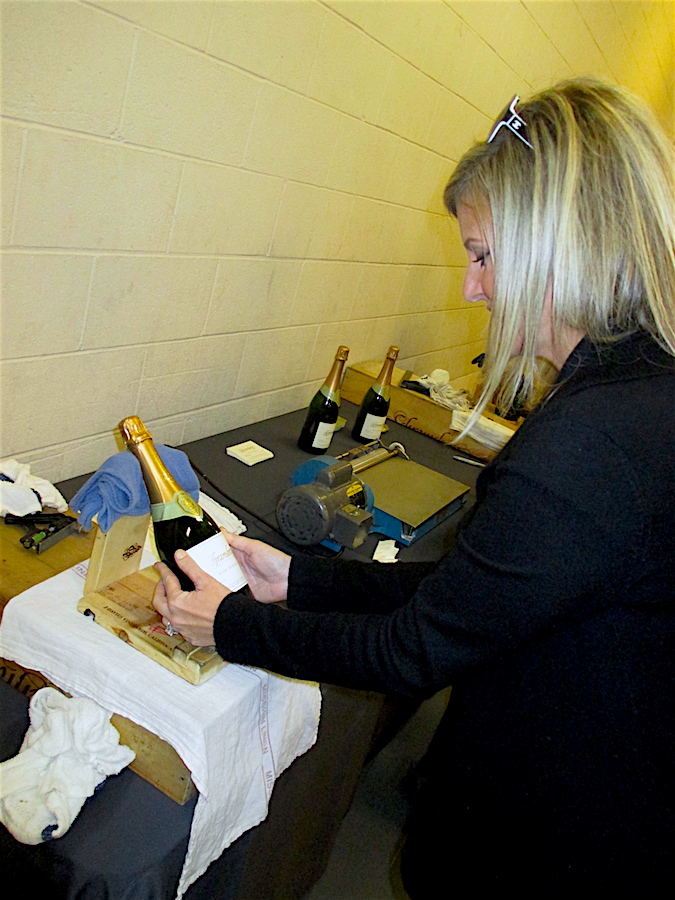
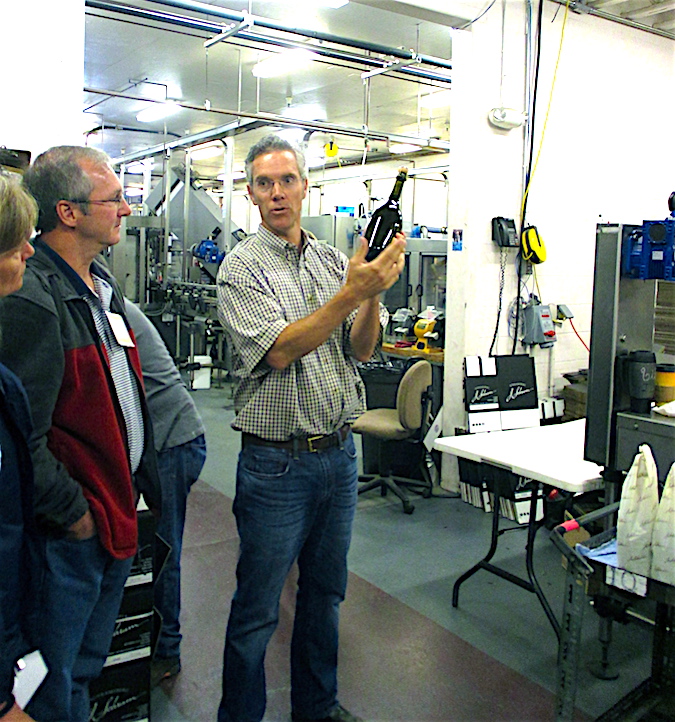
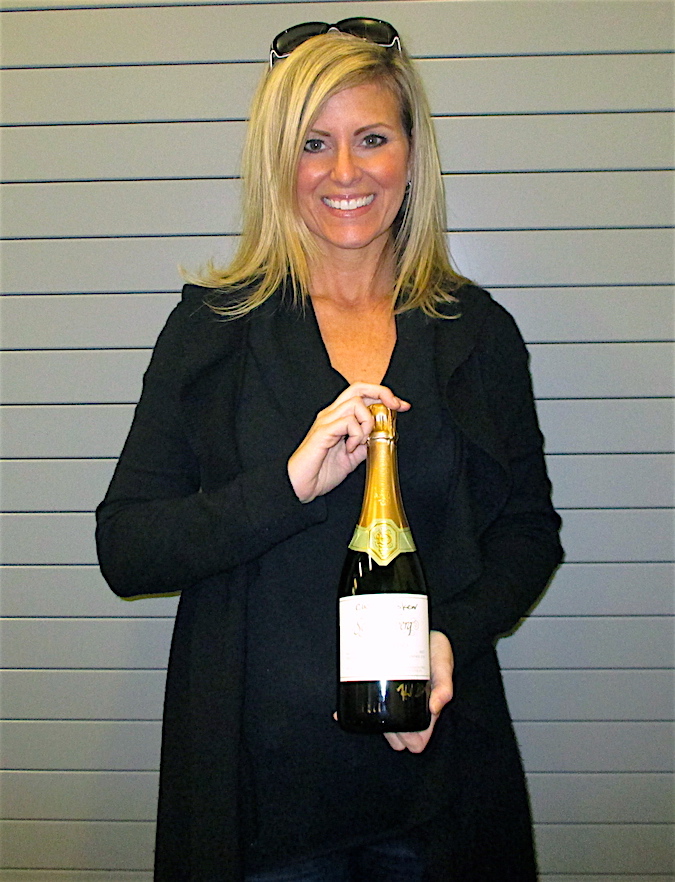 After lunch we explored the Future and Sparkling Wine on our Tables led once again by the fabulous Holly Peterson. This tasting expanded on the pairings we studied the day before and featured the Schramsberg 2009 Brut Rosé and 2005 Schramsberg Reserve. Food pairings included Beef tatake with a variety of sides and sauces including lime wedge, ginger beurre blanc, tomato concasse, yozu koshu spicy sauce, marjoram infused olive oil and Béarnaise sauce. Some surprising favorites of this class included the brut rosé paired with the beef and lime wedge as well as the tomato concasse and basil. My favorite with the 2005 Reserve was the beef and ginger beurre blanc and the Béarnaise sauce.Once we completed this tasting exercise, we were faced with a challenge! We divided up into teams and each had to come up with a 5-course tasting menu to pair with a selection of Schramsberg wines. There were some extremely creative pairings and I'm happy to report we came in second place and had alot of fun in the process!
After lunch we explored the Future and Sparkling Wine on our Tables led once again by the fabulous Holly Peterson. This tasting expanded on the pairings we studied the day before and featured the Schramsberg 2009 Brut Rosé and 2005 Schramsberg Reserve. Food pairings included Beef tatake with a variety of sides and sauces including lime wedge, ginger beurre blanc, tomato concasse, yozu koshu spicy sauce, marjoram infused olive oil and Béarnaise sauce. Some surprising favorites of this class included the brut rosé paired with the beef and lime wedge as well as the tomato concasse and basil. My favorite with the 2005 Reserve was the beef and ginger beurre blanc and the Béarnaise sauce.Once we completed this tasting exercise, we were faced with a challenge! We divided up into teams and each had to come up with a 5-course tasting menu to pair with a selection of Schramsberg wines. There were some extremely creative pairings and I'm happy to report we came in second place and had alot of fun in the process!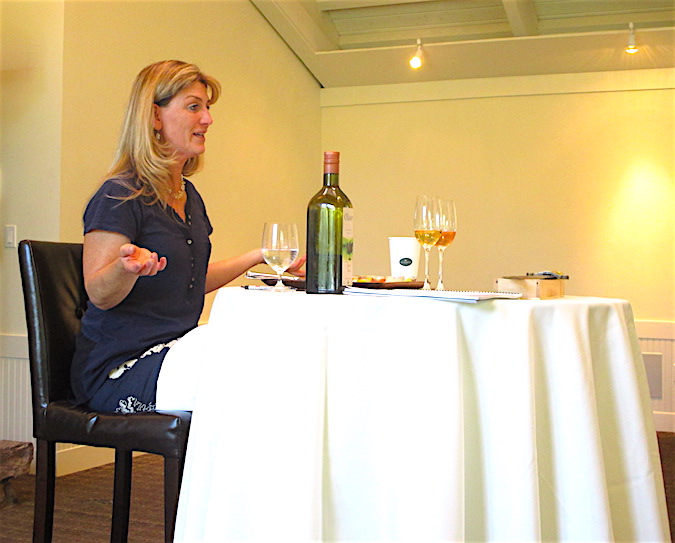
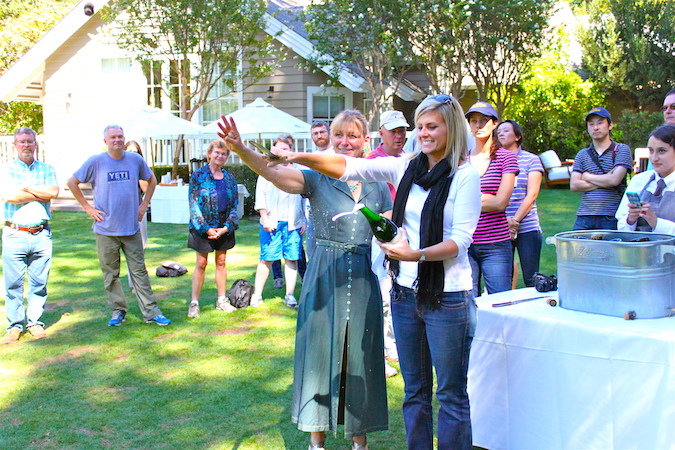 Following the competition, it was time to say our goodbyes. Camp Schramsberg was an amazing experience I highly recommend to anyone who enjoys sparkling wine. 2013 marked the 18th year Schramsberg has been hosting the camp and they've really developed an excellent program that can accommodate any level of wine knowledge - just come thirsty to learn!Cheers,
Following the competition, it was time to say our goodbyes. Camp Schramsberg was an amazing experience I highly recommend to anyone who enjoys sparkling wine. 2013 marked the 18th year Schramsberg has been hosting the camp and they've really developed an excellent program that can accommodate any level of wine knowledge - just come thirsty to learn!Cheers,

Following a fabulous evening at the Library Wine Dinner at Meadowood the night before (read more about that by clicking here), it was nice to get a slightly later start the following day. After breakfast we hopped back on the buses and headed towards the winery in Calistoga.

Day two began with a tour of Schramsberg and its caves given by Hugh Davies himself. He explained that the estate, a registered historic landmark, has been painstakingly restored by his family when they purchased it in 1965. The Victorian house, the lower winery, the barn and the caves remain largely unchanged since Jacob Schram’s days. He also informed us of Schramsberg’s sparkling wines at historically significant Presidential functions including President Nixon’s “Toast to Peace” in 1972 with China’s Premier Zhou Enlai in Beijing China which featured their Blanc de Blancs. Schramsberg’s sparkling wines have also been served at official State functions by every U.S. Presidential administration since. As we entered the caves at the winery he explained they were dug mainly with pick axes and shovels in the 60′s. He also shared the details of a harrowing incident immediately prior to the release of the Schramsberg Blanc de Noirs. The press broke and his parents Jack and Jamie Davies had to stomp the grapes with their feet in order to keep production underway to meet their deadline!

As we made our way deeper into the caves, we reached an opening with multiple rows of riddling racks full of inverted sparkling wine bottles (above right photo). Here, Hugh introduced us to a gentleman by the name of Jesus who’d recently took over as Chief Riddler for Ramon who’d been working at Schramsberg since the 1970′s. Of Schramsberg’s total production of sparkling wines 80% is riddled mechanically using a gyropalette and 20%, consisting of their more expensive cuvées, is done by hand. Riddling is a very labor and time intensive process which is very important in the production of sparkling wine. By gradually displacing and inverting the bottle, the dead yeast cells generated by the wine’s secondary fermentation move towards the neck of the bottle where it is later removed via a process called disgorgement (see video below). Jesus was kind (and patient!) enough to give us all a lesson on how it’s done. He had a way of making it look effortless however upon trying it myself I realized it definitely took years of practice to master.

After Riddling 101 we sat down to a Blanc de Blancs Progression Tasting with Schramsberg winemakers Keith Hock, who specializes in sparkling wine, and Sean Thompson, who makes Schramsberg’s still wines. During the tasting we had the opportunity to sample a variety of wines in various states of evolution ranging from a 2012 Base Wine to a 1990 Library Wine. The exercise was very enlightening and beautifully demonstrated how these wines evolve and develop over time. At the beginning of the spectrum, the 2012 Base Wine exhibited aromas and flavors of tart green apple and citrus while the 1990 Library Wine was at the complete opposite end of the spectrum featuring notes of hazelnut, pastry dough and honey. It was a valuable lesson in what time can do to sparkling wines and the complexity that can be achieved through proper aging.
This exercise led up to perhaps the most exciting and hand on exercise of the trip: we got to make our own unique bottle of Schramsberg sparkling wine to take home with us. Well, maybe not from the very beginning but were able to disgorge a bottle of Blanc de Blancs and select the dosage level, which determines the final level of sweetness of the wine, to suit our own personal taste. We donned our protective goggles for the disgorgement process but thankfully we had winemaker Keith Hock supervising us so nothing went wrong. I am happy to report my disgorgement went smoothly and when it came time to select the dosage level I decided to attempt to approximate the wine Schramsberg custom produces for the The French Laundry, a low dosage sparkler meant to pair perfectly with oysters and shellfish. After adding the dosage to the wine, I got to cork and label my very own bottle: I’m really looking forward to enjoying the one and only bottle of Cuvée Miskew!

After lunch we explored the Future and Sparkling Wine on our Tables led once again by the fabulous Holly Peterson which expanded on the pairings we had studied the day before. The wines featured this time were the Schramsberg 2009 Brut Rosé and the 2005 Schramsberg Reserve. To pair with our wines were samples of Beef tatake with a variety of sides and sauced including lime wedge, ginger beurre blanc, tomato concasse, yozu koshu spicy sauce, marjoram infused olive oil and Béarnaise sauce. Some surprising favorites of this class included the brut rosé paired with the beef and lime wedge as well as the tomato concasse and basil. My favorite with the 2005 Reserve was the beef and ginger beurre blanc and the Béarnaise sauce. Prior to this exercise I had always personally enjoyed sparkling wine with beef but it was interesting to take the time to figure out which combinations make the best pairings.
Once we had completed this tasting we were faced with a challenge! We were divided into teams and each one had to come up with a 5 course tasting menu to pair with a selection of Schramsberg wines. We had alot of fun in the process and their were some extremely creative pairings and when it came time to reveal the winning team – I’m happy to report we came in second place!

Following the competition, our last official Camp activity, we all said our goodbyes as some Campers headed to the airport and others headed to other vinous destinations. Camp Schramsberg was an amazing experience I highly recommend to anyone who enjoys sparkling wine. 2013 marked the 18th year they have been hosting the Camp and they’ve really developed an excellent program that can accommodate any level of wine knowledge – just come hungry to learn! For those of you who live in South Florida I’m also happy to report I’ll be hosting a dinner with Hugh Davies at 32 East in downtown Delray Beach on Tuesday, November 12th. Come enjoy a selection of Schramsberg’s sparkling wines as well as their critically acclaimed J. Davies Cabernet Sauvignon paired with a mouth watering menu prepared by the fabulous Chef Nick Morfogen. For more information or to make reservations please click here.
Cheers,
![]()
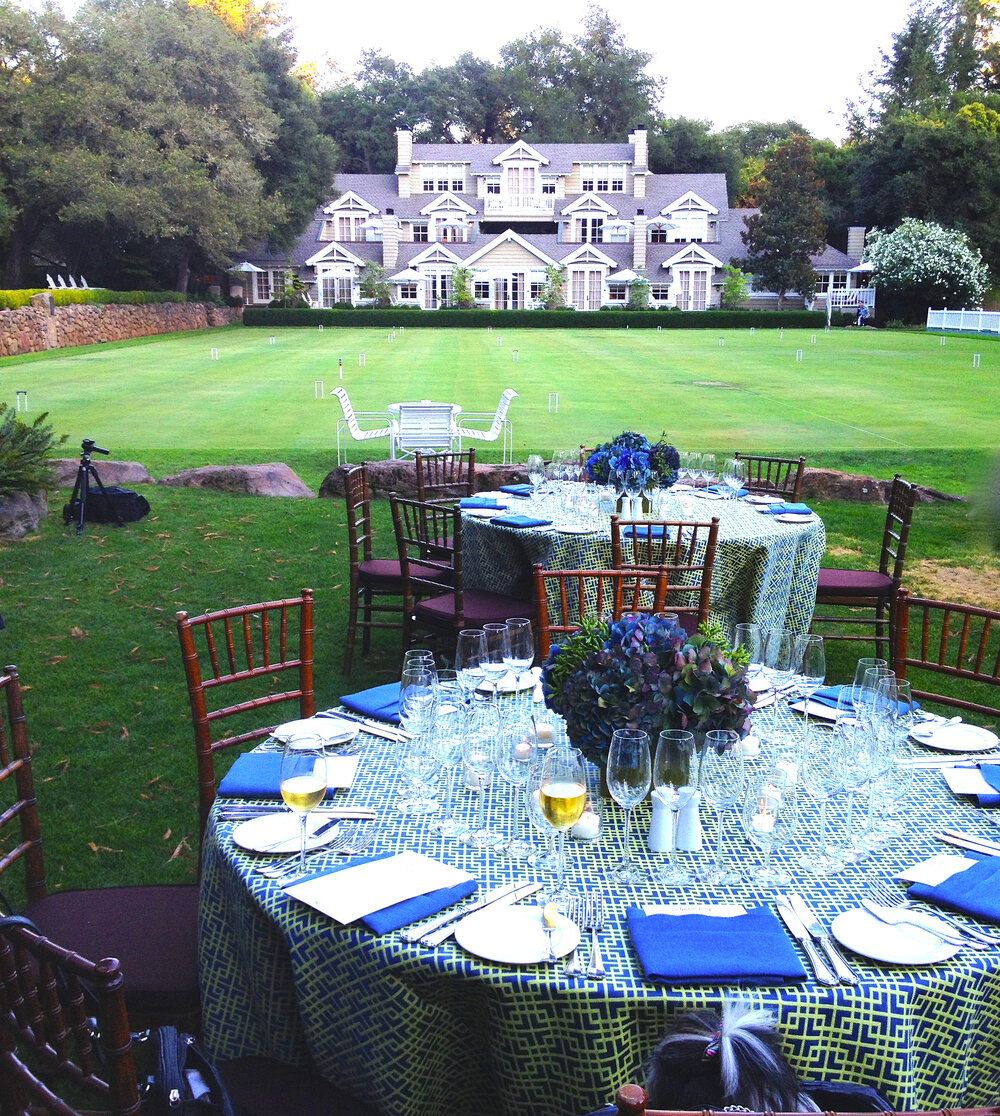
Following our first full day of Camp Schramsberg (read all about that here), Campers had the option to attend a Schramsberg Library Wine Dinner held at Meadowood Napa Valley Resort, one of the most exclusive resorts in the Napa Valley.
The Restaurant at Meadowood has received three Michelin stars in 2011, 2012 and 2013 and Executive Chef Christopher Kostow has received much critical acclaim for his commitment to local, sustainable California cuisine. In 2013 Chef Kostow received the James Beach Award for "Best Chef: West." Needless to say, I wasn't about to pass up this opportunity to experience amazing cuisine paired with Schramsberg library wine offerings!
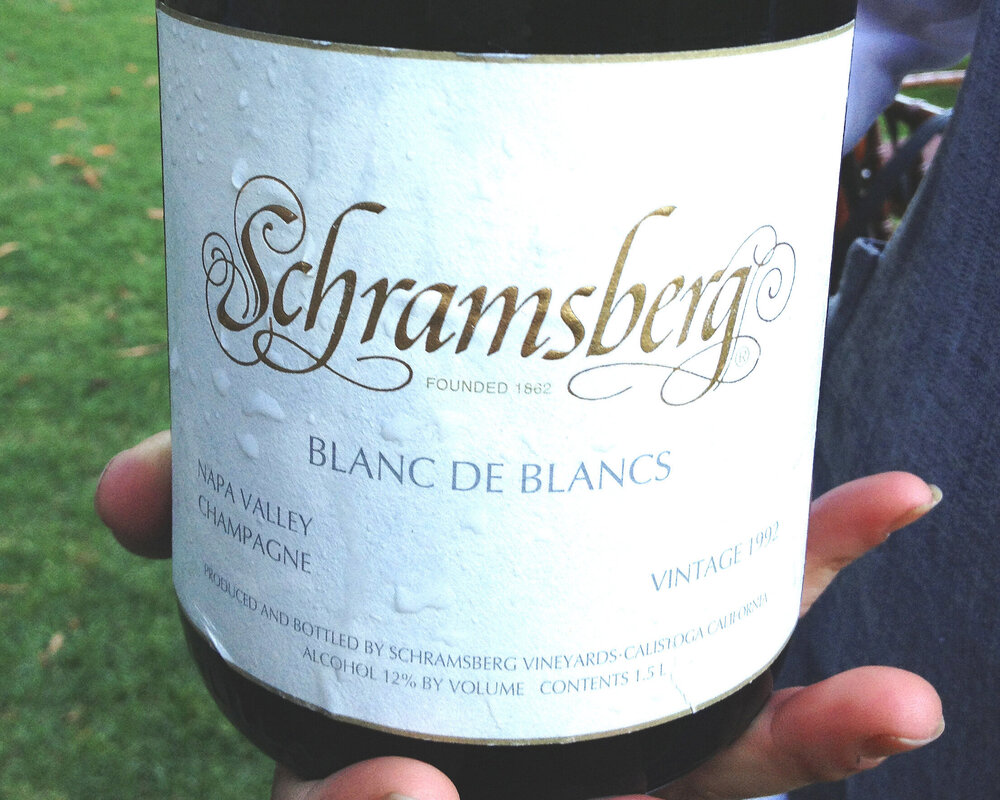
The Schramsberg Library Wine Dinner took place on Meadowood's verdant green croquet lawn and as we approached it looked like a foodie oasis beckoning to us on this balmy, wine country evening. The circular tables were draped in festive royal blue and green, geometrically patterned tablecloths and the main building of the resort loomed elegantly in the background.
We were greeted with flutes of 1992 Schramsberg Blanc de Blancs poured from magnum. Yep, we were definitely in the right place! Blanc de blancs literally means "white from whites" and is made from 100% Chardonnay grapes. This was the first wine Schramsberg made back in 1965 and was America's first commercially produced Chardonnay-based brut sparkling wine. In order to achieve added complexity, small lots of malolactic- and barrel-fermented wines are used in the blend with delicious results. Schramsberg's Blanc de Blancs gained international recognition in 1972 when President Nixon served the wine at the historic "Toast to Peace" in Beijing China. The '92 Blanc de Blancs tasted fresh and vibrant giving the impression of a much younger wine.
In fact, I had to try a few more glasses just to be sure! Dinner guests mixed and mingled over delicious passed hors d'oeuvres including Cucumber with Jumbo Lump Crab and Borage Flower that were a feast as much for the eyes as the palate. After some reminiscing about our busy day we gratefully took our seats and prepared for the deliciousness to come.
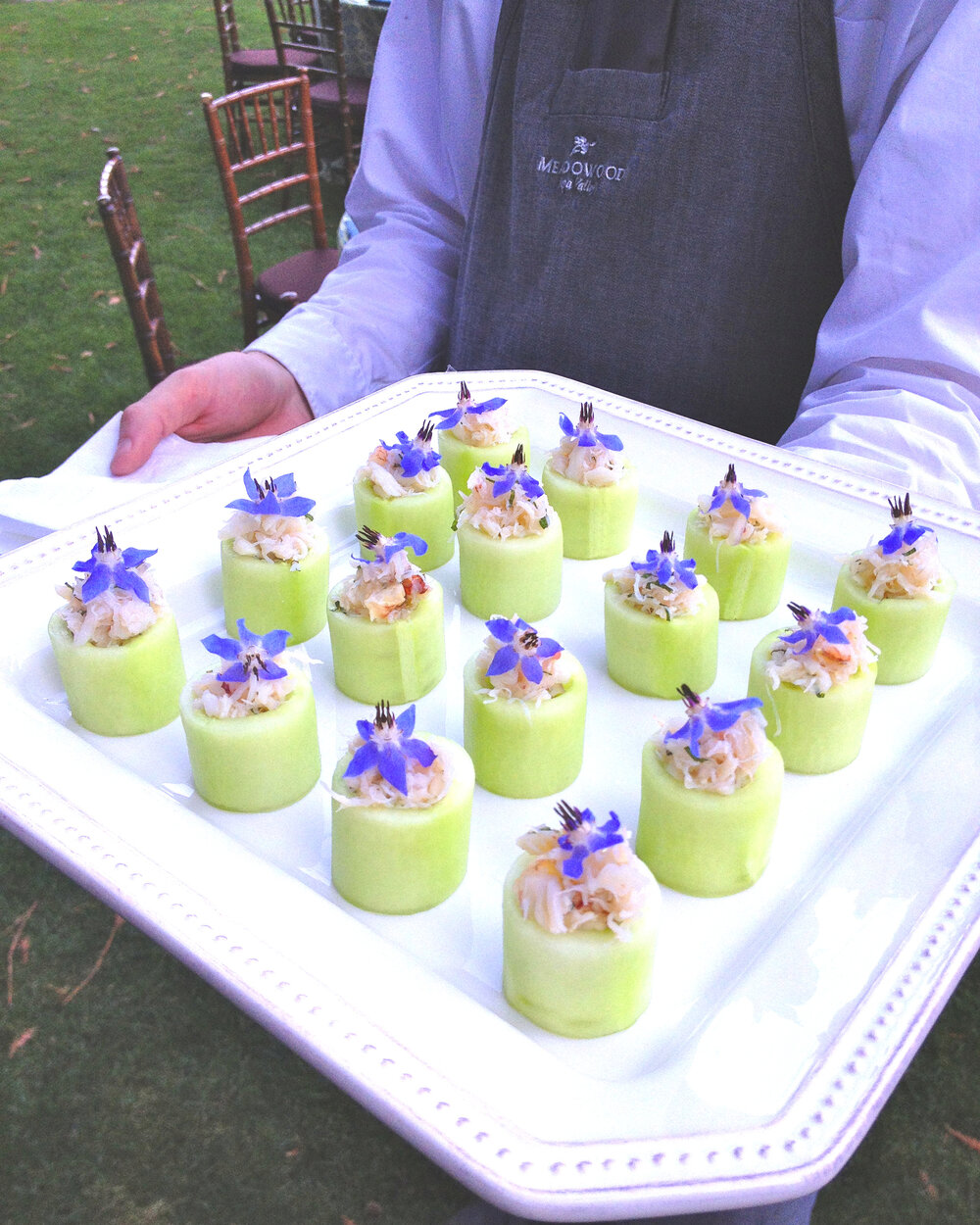
Cucumber with Crab & Borage Flowers
The first course was a beautiful Northern Pacific Halibut Wrapped in Prosciutto with Pickled Heirloom Melon, and Honeydew Consommé. The consommé was poured tableside which gave the dish extra panache. Overall, the halibut was light, flaky and succulent and the prosciutto added a delightfully salty bite and depth of flavor. Our pairing for the halibut was the 1997 J. Schram Late Disgorged, a blend of 70% Chardonnay and 30% Pinot Noir, which had a rich, toasty character with notes of citrus, baked apple and marzipan.
This special, limited edition wine was created in honor of the winery's 150th Anniversary as a tribute to Jacob and Annie Schram who founded Schramsberg, the second bonded winery in the Napa Valley. This wine spent almost fifteen years en tirage before being disgorged which resulted in lovely layers of richness, depth and complexity.
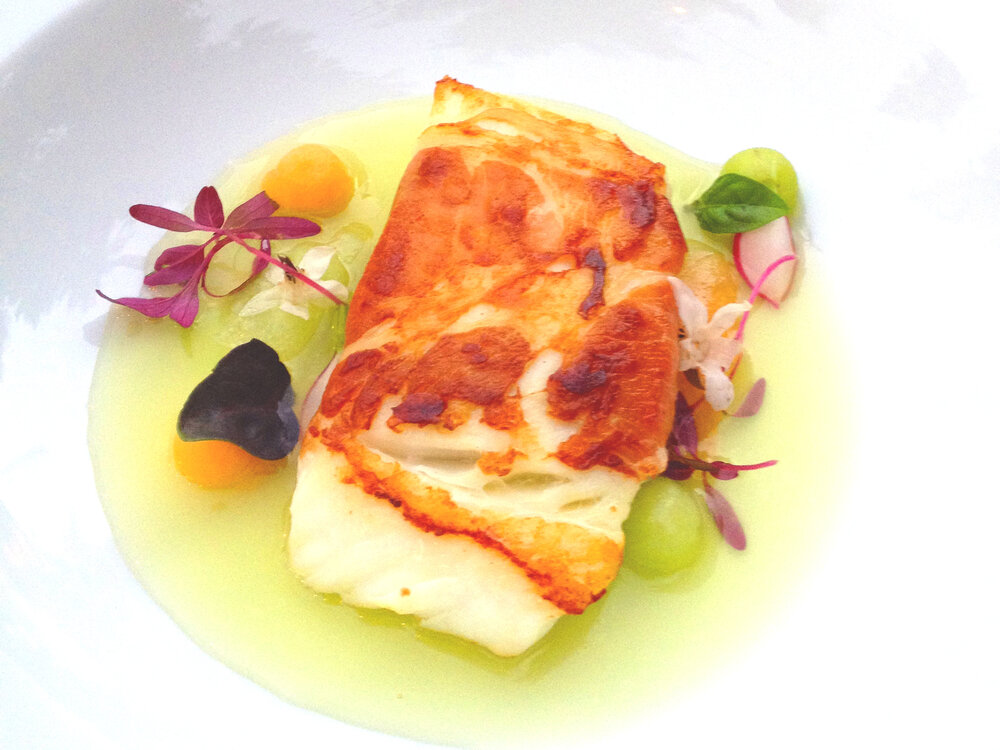
Pacific Northwest Halibut Wrapped in Prosciutto with Honeydew Consomme
Next was Roasted Duck with Smoked Potato Mousseline, Meadowood Garden Vegetables and Peach Gastrique. My table mates and I collectively agreed this was one of the most delicious duck dishes we'd ever tasted. It was lean and flavorful yet not at all fatty. With all the delicious flavor I was wondering what sparkling wine would not only stand up to, but also complement this dish.
The answer, my wine loving friends, was the 1994 Schramsberg Reserve. Made from predominantly Pinot Noir with some barrel fermented lots included in the blend, this multi-layered, full-bodied sparkler was the perfect choice. This wine's complexity manifested in harmonious notes of baked apple, pear, cherry and vanilla with an underpinning of baked pastry dough. With almost twenty years of age, this wine also tasted remarkably lively and fresh, beautifully demonstrating along with the previous wines of the meal the capability of sparkling wines to age with grace. As far as the pairing, the flavors of the wine and the duck worked beautifully together creating a fabulous synergy. This was definitely one of the most memorable pairings of the weekend.
In lieu of dessert, we were treated to a cheese course featuring Mt. Tam Cheese with Pine Nut Crostini, Quince and Stone Fruit Compote with our final wine of the evening. Mt. Tam triple cream cheese hails from the well known Cowgirl Creamery and is named for a Northern California landmark, Mt. Tamalpais. It is made from fresh, organic milk from Strauss Family Dairy and has a decadent, creamy texture.
The wine pairing for the cheese course was the 1999 Schramsberg Crémant Demi-Sec. The delicious richness and complexity this off-dry sparkler had developed after almost fifteen years made it a dessert in and of itself. Notes of pineapple, citrus and honey accompanied alluring spice notes as well as a fresh and balanced acidity.
This unique bottling is a dessert wine crafted from a unique blend of grapes including Flora (a cross between Sémillon and Gewürztraminer developed at U.C. Davis), Gewürztraminer, Pinot Noir, and Chardonnay. This wine was California's first “crémant” when it debuted in 1972 and the word crémant, which is French for "creamy," perfectly describes this delightful wine that has less pressure and a softer effervescence and mouthfeel than other cuvées. This wine also has some historic significance as it was served at President Reagan's Second Inaugural Luncheon, President Clinton's dinner for the Prime Minister of Canada and, most recently, at the sixtieth wedding anniversary of President and Mrs. George H.W. Bush.
Needless to say after a day of such decadence, we were all ready for bed and looking forward to Day Two of Camp Schramsberg and the adventures it would bring!